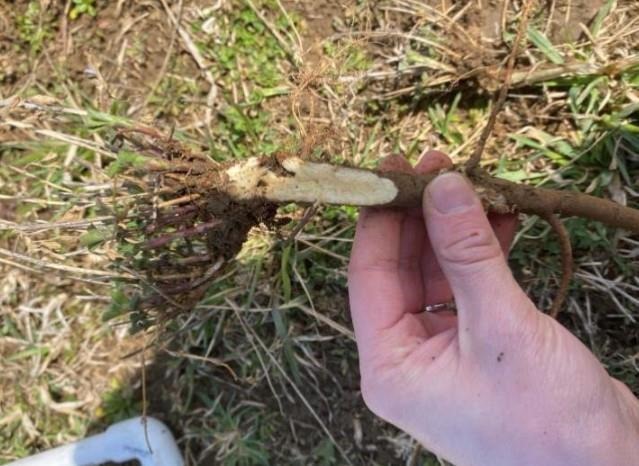By Rebecca Vittetoe
As forage stands start to green up this spring, take time to evaluate the stands for any winter injury. It will be especially important to check stands that had significant armyworm damage last fall.
As you evaluate forage stands, Tables 1 and 2 below can be used to help determine what type of action may be warranted in a field. Note that while older stands typically have fewer plants per square foot, they produce more stems per plant. As a general rule of thumb, plan for 100% of normal season yield if there are 55 stems per square foot, regardless of the stand age.
Table 1. Suggested plans of action based on observations and alfalfa field conditions.
Observation | Condition | Action |
|---|
At green-up |
Large dead areas | | Plan to rotate. |
Small dead areas | Some stand loss | Consider reseeding small areas. |
Random injury of a few plants or very small areas | Some stand loss | Consider stand as a whole - if it's too thin to keep - rotate
- if unsure - recheck in 2 weeks
|
General plant health appears normal | Little to no damage observed | Recheck in 2 weeks to be sure |
At 3-inch growth |
Damaged areas increasing in size; plant health deteriorating | Stand is getting worse | Is stand adequate? - No, rotate.
- Yes/maybe, recheck in 2 weeks.
|
General plant health normal or improving | Little or no damage | Plan for normal harvest. |
At 6-inch regrowth |
Plant growth is far enough along for the stem-count evaluation method. | >55 stems per sq. ft. | Plan for 100% normal season yield. |
55-40 stems per sq. ft. | Expect 0 to 30% season yield reduction. |
<40 stems per sq. ft. | Consider rotating unless grass mix is present; if so, fertilize with N to encourage the grass. |
Table 2. Recommended plant counts per square foot in either pure alfalfa or alfalfa-grass mix based on the age of the stand.
Stand Age | Pure alfalfa | Alfalfa-grass mix |
|---|
Seeding year | >20 plants in fall | >12 plants in fall |
1st production year | >12 plants in spring | >8 plants in spring |
2nd production year | >8 plants in spring | >6 plants in spring |
3rd production year | >5 plants in spring | >4 plants in spring |
4th production year+ | >4 plants in spring | >3 plants in spring |
Modified from Table 2 in PM 1362 “Evaluating Hay and Pasture Stands for Winter Injury”
Additionally, as you are evaluating stands, dig plants from several representative areas in the field and evaluate the crown and root health, looking at the crown size, symmetry, and how many shoots are present. Slice open the crown and root to check for rot or discoloration (Figure 1 and Figure 2). More information and visuals on assessing an alfalfa stand can be found in the University of Wisconsin publication “Alfalfa stand assessment: Is this stand good enough to keep?”.

Figure 1. Healthy white tissue in the crown and taproot of an alfalfa plant with lots of new, symmetrical shoots.

Figure 2. Alfalfa plant with discoloration in the taproot and crown, very few new shoots and less symmetrical.
Possible remedial actions could be doing some patchwork seeding, keeping the field for a first crop cutting and then rotating, or rotating to a new crop immediately.
Perennial forage grasses often overwinter better than winter-hardy legumes. However, orchardgrass and ryegrasses are more susceptible to winter injury than other perennial forage grasses. Visual evaluation of grass regrowth and health of crown tissue is suggested when evaluating winter survival of pastures.
Reseeding in hayfields or pastures might be needed. It is not recommended to reseed alfalfa into stands that are 18 months or older due to the likelihood of autotoxicity. Overseeding or drilling grasses or red clover into thin or winter damaged stands ideally would be done before May 1. Seeding after mid-May increases the likelihood seeds will germinate, but less frequent rainfall may allow the soil to dry out before roots are deep enough to reach moist soil, killing the seedlings.
Source : iastate.edu